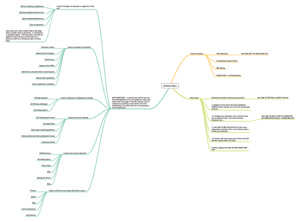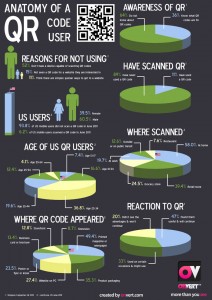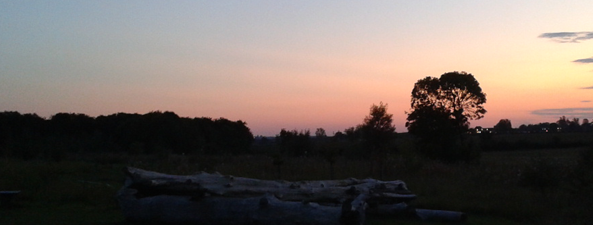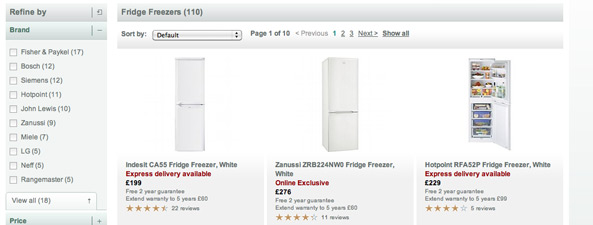SEO or Search Engine Optimisation is the process whereby web pages are designed, built and modified to increase visibility in non-paid (organic) search engine results pages (SERPs).
There are two ways to be found in Google, one, to pay for visibility, and become a sponsored listing, or two, to achieve visibility in natural search listings, organically. Combining the two is super, but the foundations of being listed favourably are in organic SEO.
You can define organic search engine optimisation as the process whereby pages are designed, built and modified to increase visibility in search engines – essential knowledge for designers, and developers.
Of course, a word of caution before we begin – it’s absolutely useless optimising if your site is unusable or irrelevant to visitors. They are always your priority, not search engine robots. No good advertising a shop that’s closed for business, or has no front door.
Clear Ground for Crops

Photograph: Valley Farm, West Wratting by Andrew Stawarz on Flickr, Creative Commons License
The most ideal situation is embarking with organic SEO for a new site. Here, a clean, blank slate exists with no pre-existing visitors, structure, code or setup. Bliss.
The strongest SEO strategy is considered right at the start, with content, navigation, domain, and market. Quite often the client has established their market, name and domain, so the focus is on design and development, than wider market research.
Code & Content Outlines
Consider the code content order in your design. Humans can skip about the page to look at content in any order they choose. Search engines read the HTML code from top to bottom. Top to bottom of your code may be quite different from top to bottom of what you see in your browser. Therefore, decide early on how you will structure your code, so that the most important content is seen quickly by the search engine. Don’t hide your page specific content 1000 lines down your HTML.
Establish your headings. There are six headings in HTML, which a search engine uses to make sense of your content. In the majority of cases, you will only need headings one to three. Always make efforts to use in order: H1, H2, H3. Avoid jumping down the list and missing a heading out. Use one H1 tag per page – containing unique page content if possible.
Use headings correctly. Don’t wrap heading tags around something that isn’t a header, just for the sake of using the CSS styling associated with it. If you wish to draw attention and make a word in a paragraph stand out, consider strong or em tags instead.
Further Reading:
Organise Content & Files, Rewriting if Necessary
Map out your content. Picking the content to go on a website may be difficult for clients, providing outline assistance at the very least can improve the process. There are commonly reoccurring pages such as home, contact, products, about, and often testimonials or case studies after that. You need to know how you will structure the content and its relevant files, even if you are using a database to hold the content. Once you have this outline, draw it out as a hierarchy.
Not only will mapping out your content and organising your files save you time and help you find things, it assists with URL rewriting.
URL rewriting is the difference between naming your About Us page page1.html and /about/. Not only does the search engine understand it’s the About Us page far more easily, so does the visitor, and remember, visitors are the most important people to your site.
Use hyphens rather than underscores to replace spaces, for instance, about-us and not about_us as this is easier to read, and decreases the likelihood an underscore will be missed by default browser styles underlining a URL.
Apply the reasoning: if someone sent you a link to www.a-website.com/23409/ vs www.a-website.com/guide-to-youtube/ you would be far more likely to trust that the second address is going to take you to a guide on how to use YouTube.
Google uses the words in your file name and URL structure to help determine the relevance of your page to entered search terms, highlighting matches in bold – see brief is emboldened in the URL of the first search result above, along with the page’s title text, and description.
If you are only considering a smaller, static website, it may just be worth your while physically organising the files into folders and not worrying about programmatically rewriting. Examine the hierarchy or outline of your pages, and use that to guide you. For instance, you may have lots of products, which may group into categories. So you might either opt for /categoryname/productname/ file structures.
For larger sites, particularly those in ecommerce, and blogs, it is more practical to maintain if you manipulate URLs using automatic methods, such as the settings in the content management system adopted, or server rules.
By deciding your file structure early in a new development, you avoid the headache of trying to apply it later.
Further Reading
Minimalist Technique
It is good practise to extract as much from your code as possible. Avoiding clutter and bloat ensures your code is manageable and well organised for you, or any subsequent developer, to maintain. If you believe you will retain your job simply by writing something overcomplicated, you suffer the overheads with maintaining the code in the meantime. Besides, code bloat slows everything down, and damages the site’s organic SEO potential. Just don’t.
Keeping the code clean means removing any needless clutter – this includes inline CSS you have tacked onto your HTML as you developed, blocks of commented out or hidden code, and JavaScript into external header files. Clean code is not only faster, but it is easier to maintain. By starting out neat and tidy, it’s far easier to keep your code minimalist and organised.
Where Crops Have Grown Before

Photograph: Barton’s Farm in Flower – Winchester by neilalderney123 on Flickr, Creative Commons Licence
In more cases than not, there is no clean slate to begin with. The client has either an existing website they need to be replaced, or worse, a poor website they wish to be promoted in Google. In these situations, execute damage limitation and scope out client requirements, budget and if it’s a challenge you can take on sensibly.
Take a Site Survey
The source code in your browser is not always entirely reflective of the full source of a website. It is far better to examine the real source files. That way you can discover any potential issues such as lack of templates, poor file-naming, or any custom back ends that will need maintaining or improving to help the site establish a better organic foundation.
Examine Existing Live Statistics
If no statistics exist, or are only measuring the number of visits, offer to add them for a minimal amount, even if you end up backing out later. Stats allow you to see how the website is doing in its current state – though you may need to study at least two weeks worth of statistics to get a better informed picture of the situation.
Ask particularly to view live stats, not printouts, if at all possible, so you can verify true values. Stats reveal current organic traffic levels, and the site’s pre-existing strengths. It will also reveal to the website owner how poorly a site is doing, if they are previously unaware, or have bloated expectations.
Further Reading
Talk to your Client
Sit down with the client and talk them through where the site is now and outline your subsequent proposals. Follow your gut instinct, don’t go into elaborate detail, unless the agreement is to pay for your advice, and someone else to carry out the work!
Be aware that code changes are often invisible to clients, as they are under the bonnet changes. They may question the validity of work, and suspicious that you have performed no work – and produced the Emperor’s New Clothes. Be prepared to back up your plans with examples and verifiable sources – especially official Google sources.
Remind them that these are long term improvements, and there is often no magic bullet.
Further Reading
Limited Budgets
On a limited budget, look for the small changes to bring biggest potential improvement. Depending on the site, this may be setting up unique title tags, or setting up a Meta description for the core pages.
Other common changes include replacing Flash or JavaScript menus with search engine readable links, setting up h1 and h2 tags, or adding and submitting an XML sitemap.
Mind Your Head

Photograph: 365.193 – mind your head by nettsu on Flickr, Creative Commons License
A surprising amount of organic SEO takes place within the header of a webpage. If you previously shied away at understanding the odd tags and requirements of a header of a webpage, you are overlooking a significant step in the process.
Valid Doctypes
At the very top of your code is a Doctype declaration or DTD. These advise the browser on the type of code it is about to receive, and allow it to make informed decisions on how to display the following code, and apply the correct rules. There are a variety of Doctypes, though the majority of people will stick with HTML 4.01 Transitional.
Not declaring a valid Doctype invites rendering difficulties, and demonstrates poor coding standards, relying on the browser to make assumptions on how to render the code correctly. It’s also about efficiency, and applying standards to your work. Like holding a driving licence, it shows what the code should be able to demonstrate, so don’t let it down by using bad code afterwards, swerving all over the road.
Further Reading
Title Tags
Possibly the easiest part of a header to pick out, they are displayed by browsers in the title bar (and/or tab title) and used by search engines to display the big blue link to your site in results listing.
Titles should accurately reflect the page content, with the target keywords, preferably weighted at the start of the phrase. Focus particularly, almost exclusively on the first 70 characters of your title.
Ideally, each page should have an individual title tag. If you can set a standard, generic fallback for the days you forget to set one, it is better than having no title whatsoever. Titles have a significant influence on keyword relevance for search engines, and should not be ignored.
Bad Titles
- There was a farmer who ploughed all day…
- Home
- The Organic Company :: Products
- Farmer Stories, Stories About Farmers, Farmer Stories, Farmer Tales, Farmers, Farmers are Cool, Farmer Stories
Good Titles
- Farmer Stories | Stories About Farming | Farming Tales | Agricultural Literature
- Flat Caps, Dungarees, Clothes for Farmers
- The History of Farming in Britain – The Organic Company
The bad titles are either poorly descriptive, too long, repeat themselves, are just lists of keywords or have generic information at the start of the title. The unique aspect of the page and its content should be first, within those 70 characters.
Consider rephrases of your target keyphrase to aid appearing in alternative search terms, but don’t overdo it. The extra phrases will be of little use, if you do not back the phrase up elsewhere within the description and copy.
Further Reading

Photograph: Planet – Jones Valley Urban Farm by southernpixel on Flickr, Creative Commons License.
Description Meta Tags
Description Meta tags, like titles, work best when they are unique to the page they are describing. If you have hundreds of pages, start with your core pages, and consider a generic fallback for others at least, as it is important not to leave this blank.
The description Meta tag is used by search engines to populate the description for each search result; it is also a priority indication as to how relevant the page is to the entered search term. Therefore, you should include your target keywords again in the description, preferably towards the start – for example:
- Read farming stories in our extensive collection. Find stories about farming in Britain. Famous farming tales, agricultural literature.
This reflects the keywords from the title tag, and the page content, complete with a friendlier summary.
Further Reading
Keyword & Other Meta Tags
Pay little heed to this depreciated header tag. It’s only handy for more obscure search engines, or for keeping track of your target keywords for your page. Google have no plan to use it again after dropping it years ago.
Other Meta tags you may want to use in the header would include verification tags set by Google, Yahoo and Bing to use their enhanced webmaster services, and the charset Meta tag to define the content-type and character set of the page.
Often the default is UTF-8, though depending on your language, you may need to use alternative character sets to support all the characters.
Other tags to note are robot commands such as NOINDEX or NOFOLLOW, which prevent links indexing.
Further Reading
Refine Content

Photograph: M&Ms Sorted by Color by Mr. T in DC on Flickr, Creative Commons License
Above all other content on your website, text is king. Text content should be your priority and focus, as this is the content that the search engine can index. Search engines are blind to pictures, colours and videos and deaf to audio. Therefore, never ever use images, flash or similar for text. It’s not seen by search engines, its not accessible and easily readable by human visitors, and its all round poor practise. The only time there is an exception, is for use as a CAPTCHA (antispam) which you should never expect a search engine to bypass anyhow.
Fancy Fonts
Don’t be tempted to make navigations and titles into images just for the sake of being able to define an unusual font. Using CSS you can declare fonts from a shared default pool, such as Arial and Verdana. These can be fairly uninspiring for designers. By declaring a font that is not commonly to different operating systems, you risk your visitors seeing the fallback font, and stumble into potential rendering issues, so an alternative method is required.
Images might seem like an easy answer, but they are troublesome to update, and often invite typographic errors. If you must use custom fonts, look into @font-face font embedding solutions, or font-replacement solutions such as Cufón.
Further Reading
Images
Despite the focus on text, do not underestimate the power of imagery to your human visitors, who are your priority. Images can be partially search engine readable by assigning individual alt and title tags. Image search is also an often overlooked entrance to your site. By adding the alt and title tags, and also naming the image file descriptively, you can improve the visibility of it within image searches, tempting visitors into your site through yet another route. Consider hyphens to split two words or more, not spaces or underscores, just as you would page names.
Further Reading
Video & Audio
Video and audio is an altogether different beast. Diverse content is attractive for your human visitors, but the search engines will miss out. Sometimes even your visitors would like a summary or transcript below, especially if they are on a slow connection, or have difficulty understanding the language or accents of those on screen. Transcripts are good for dropping in links to related content.
Further Reading:
Text Content
The important thing to remember is that you can only be found for what you write about. It’s no good trying to rank for green tractors if you never mention them. Put the phrase regularly, link on it, put it in titles and descriptions, your H1 tag, image alts and titles, image names, but don’t get pedantic and risk keyword stuffing. If you think it’s repetitive, it probably is.
Be sure to use friendly, understandable content throughout the website. Your client may describe themselves as a multifaceted solutions provider but nobody is actually going to search for that phrase, are they? Discuss with the client what their customers really will be searching for, to stumble across them, and focus on getting those phrases into the content instead.
If you are short on content, whatever you do, don’t repeat yourself. Duplicate content is bad news. Say it once or not at all, or risk demotion in Google. If you have discovered duplicate content on your client’s site, deal with it as soon as you can by removing it and using a 301 redirect for anyone unfortunate enough to venture to the old address.
Generic industry content may seem pointless to include, after all, your client may expect their audience are all experts in the industry who don’t need to be retold the basics? Never assume your visitor is always your exact target audience.
Wider descriptive or explanatory text about your industry not only gives you increased content, and therefore more chance to rank for your chosen phrases, but can assist newer customers in your industry. Assistance begins a trust relationship between customer and company.
If the extra information is really useful, and a good guide, the likelihood is that visitors will want to share it around, which is another positive, building links for you.
Ensure you carry out regular updates for the content, especially pages with date specific content. Visitors will be less encouraged if they find your site has no news since 2002. Always maintain your text, especially if it covers legal or health related content, for which out of date advice could be dangerous or cause you problems.
Always include contact details. Putting them at the bottom of each page is a good prompt for visitors to contact you. Placing your number prominently at the top of the site is not only a visual prompt to call, but increases the likelihood of the telephone number being well indexed – handy for a visitor wishing to contact you swiftly. Telephone numbers and email addresses are often sought by visitors as opposed to filling in contact forms. Contact forms do have the added bonus of being able to prompt visitors for specific information.
Further Reading
Content Enrichment
Once your content is established on the site, ensure you back it up with an informative sitemap. Sitemaps come in two forms – a physical page (though beware not to go above 100 links on that page if possible) but also as an XML sitemap. These are hierarchy documents just for search engines, which help them index your pages efficiently. You can create them using software, or you can use online sitemap creators to crawl your site for you, and create a map.
Once you have created an XML sitemap, upload it to the same domain as your site, and use the respective search engine website centres to notify them. When you add and remove pages, remember to update this, or look at solutions to dynamically create the sitemap automatically.
If there is any possibility of an international market for your client, or even a local bilingual population to break into, it is worth translating the core content and meta content by a human translator.
Further Reading
Know Your Neighbours

Photograph: Sprouting Spuds at Hayes Valley Farm – 5/13/10 by edibleoffice on Flickr, Creative Commons License
Organic SEO is not only about the code and content of your website. It is also about whom you talk about, and who talks about you, so it pays to have a few friends.
PageRanks & Site Authority
Every website, and every page indexed by Google is given a PageRank between 0 and 10. The majority of sites may only achieve ranks between 0 and 5. Well respected sites may achieve higher ranks, for example, Twitter achieves PageRank 9. The higher your rank, the higher you are promoted within Google’s search results, as it measures the level of community respect and content authority by this number.
PageRank is roughly exponential. Progression up the ranks is not straight forward, and not merely based on the number of links to your site from others. Climbing to the next rank becomes progressively more difficult.
To begin building up a PageRank, you need to find people who will link to you. When you are beginning from scratch, with a PageRank of 0, it is worth doing the leg work and establishing links in popular free directories or local listings to set the ball rolling. However, your best tactic is always to scout out websites with a higher rank than yours, or at least the same rank.
Unfortunately links from sites with desirable PageRanks often require you to pay a subscription or listing charge in return. Those that don’t, tend to be run by savvy administrators who will be unwilling to exchange a link with you unless you have a similar PageRank, making the exchange mutually beneficial.
Occasionally you may get lucky, particularly with local community run sites, who will view linking to your website as beneficial for visitors, rather than a gain for their search engine listings. If you don’t ask, you’ll never know.
Further Reading
Building Links
If you want to link build for your client, you will need to establish a links page within the site. Clients can be quite resistant to adding such pages, because they are potentially advertising directories – which list competitors. Without reciprocal links, good directories will not list your client’s site, or you may not be able to make use of favourable listing positions towards the top of pages. Linking to a small page in your footer should be enough – the payback is often worth the small inconvenience.
If your site has multiple domains, it is essential you root them all into one favoured domain. This falls under Google’s duplicate content rule. Having a favoured domain allows you to focus your efforts in one direction, and build up a good rank.
Links need maintaining, so make regular check with software. Keep track of who you have requested links with, so you can check links remain on external sites, and notify the website owners if there if the link is incorrect. If you were rejected, make a note of why. It may be that you can approach them again at a later date.
Further Reading
Link Quality
To add a further twist, link density can influence link value. For every link on a page, the value it gives the receiving website reduces. Imagine a strong black coffee. This is a web page with no links on it whatsoever. Adding a link dribbles some milk into the mug. Adding more links dribbles yet more milk, until the coffee becomes weaker. If you are featured on a page with few links, it makes that metaphorical coffee stronger, and the link has all the more value.
Educational and government websites, with domains ending in .edu .ac.uk .gov and .gov.uk are considered to be of high value if you can get a link from them, but hideously difficult to achieve. It is historically believed these domain types were habitually more authoritative due to their restrictions on use, though it is a claim currently in dispute.
Being listed at the top of a page is better than at the bottom. It has the added bonus of increased visibility by visitors to a directory. Often top listings are again restricted to those who pay, so do your homework first. Find the directories and sites that appear high in the results for your favoured searches and piggy back their high listing. Alternatively look at directories with the best Page Rank and invest there.
Some directories will lure you in, but in the end charge you for adding the website link. Listings without links won’t add quality to your organic SEO, but they will faintly help promotion in general.
Further Reading
Let the Competition Find the Links
If you are investing time into building organic SEO for a portfolio of clients, or an extensive campaign for a big client, it is worth your while investing in some tools. Software can survey the position of the site, and its pages within search engines and report back, without you having to search by hand, or use Google queries.
Good software will also allow you to scope out the competition, studying the leading results for a search term. By surveying who links to these top results, you can discover unusual places to become listed, and discover high ranking websites to approach. Discovering the reason for your competitor succeeding for phrases you are currently finding difficult to rank for, can be most enlightening!
Further Reading
Patience
Organic link building takes time and effort. It may be some time before you see results. Monitor your referring sites in your stats to pick up on the in links that are giving you the best results – not only by number of visits, but how long the visitor stays, and what pages they visit. Occasionally your email requests for a link may take weeks to be responded to, and listing in DMOZ can be a never ending wait due to their lack of editors.
Keep Track

Photograph: Tracks – Instax Windows by Slightlynorth on Flickr, Creative Commons License
Always keep track of your efforts. Sometimes you will be surprised at where small efforts can turn about big results. Use the results and reactions to plot your next move. Don’t rely only on the statistics reported in your analytics, keep updated with the number of calls and contacts via the website, to seek correlation.
Watch for an increase in organic search engine traffic, an increase in time on site, and a lowering in bounce rate. Your top page according to focus may also vary and adjust to reflect your efforts.
Site Indexing Inclusion Ratio
Nice, simple number that can be done with Google, as long as you know the number of pages in the website you are surveying. Type site:www.yoursite.com into Google (of course using the desired domain, not yoursite.com). Google will return the pages it has indexed for the site, and at the top, the total number indexed.
Calculate the inclusion ratio by taking this total number, and dividing it by the number of pages that are really in the website. The closer Google’s total is to you the number of pages, the better. If it is low, check what pages are indexed, and work on interlinks between your pages and your sitemaps.
Use Google alerts to monitor when content is indexed. You can set up a number of alerts to notify you by email when new pages are included, or when a phrase is included in news or other results.
Further Reading
Inbound Links
Google can return its identified inbound links to a website, or a particular page, according to its index, if you enter link:www.yoursite.com as a query. This is useful to keep a tab of to monitor your progress with link building. Using it to query particular landing pages may also be enlightening.
Conclusion
Not every method will be viable for each site. As you experiment and try out different techniques, you will often find that no one method is the answer. Some markets are habitually more difficult to optimise for than others.
By engaging with organic SEO, you may be able to save money on PPC and ad campaigns, by appearing in the top results for a search term consistently with minimal maintenance.Organic is a long term solution, though its financial investment is often lower than PPC, and its outcomes are retained for some time, even if a site is eventually neglected.

































